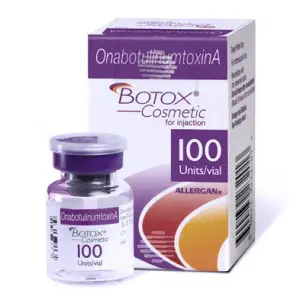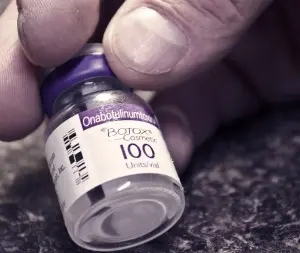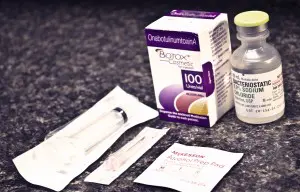Is Botox® Cosmetic Safe?

I have a patient who wants to have a BOTOX® Cosmetic treatment but is afraid. She has read the internet and has seen many comments of adverse side effects from botulinum toxin type A treatments. My first response to her was of course BOTOX® Cosmetic is safe. In one form or another it has been used for over 25 years and has a sterling track record.
After I thought about my anticipated response to her, I realized that I had never really researched any articles about botulinum toxin type A nor read any of the blogs that related patients’ bad experiences after a treatment. So I decided to do my homework. Here is what I found. Please note that in this discussion, I am focusing on BOTOX® Cosmetic which is used in aesthetic treatments. The number of units used for BOTOX® Cosmetic treatments is far less than the number of units used in medical therapies with BOTOX®.
Botulinum toxin type A is the active component in BOTOX® and BOTOX® Cosmetic. BOTOX® was FDA approved in 1989 for medical therapeutic use for strabismus and blepharospasm. The Drs. Carruthers in Canada were treating patients using botulinum toxin type A for these conditions in their practice and realized that there was an effect on wrinkles besides helping reduce the muscle contractions associated with the conditions. This lead to the FDA approving BOTOX® Cosmetic in 2002 for the treatment of wrinkles known as the glabellar lines (frown lines between the eyebrows).
Since being FDA approved, BOTOX® has been used for more and more medical conditions. BOTOX® Cosmetic’s use is also growing. In 2008, it was reported that world-wide there were 3 million botulinum toxin type A treatments a year4, and that up to that time there had been 15 million treatments6. In 2013, there were over 3.5 million U.S. patients2 who received 6.3 million botulinum toxin type A treatments1.
In 2002, there was a case brought against Allergan from a woman who claimed that after a BOTOX® treatment for a then off-label use for migraines she developed unbearable migraine, fatigue, neck weakness and difficulties breathing and swallowing for four months. She lost her case against Allergan, but the company admitted that the product insert stated that BOTOX® had unknown risks as an anti-wrinkle treatment in doses higher than 20 units and acknowledged that the drug could spread to other areas of the body3. Allergan’s clinical studies had shown a potential link to headaches, pain, flu-like symptoms and respiratory problems3.

In 2006 there was a report of 4 adults who were felt to have developed botulism after cosmetic injections. However, the botulinum preparation used was an unlicensed, highly concentrated mixture, and the patients received doses 2857 times the estimated human lethal dose. There is no report of them dying5.
In 2008, 15 BOTOX® users and their relatives sued Allergan claiming that the company failed to warn of the drug’s dangers. There were four deaths which included two children and two adults involving off-label use of the drug. The children received very high doses for limb spasticity related to cerebral palsy. One adult died from complications from injections for neck and shoulder pain, and one died from treatment for excessive salivation. Of the remaining eleven plaintiffs, the complaints were for droopy eyelids, numbness, headaches and swallowing and breathing difficulties. Three in this group had been treated for cosmetic reasons, but it was not reported what dose was used or which complaints they had6,7.
Later in 2008, a Consumer group called Public Citizen reported linking 16 deaths to use of botulinum toxin between 1997 and 2006. They also reported finding 180 adverse effects reported4. I cannot find any information on the actual patients in this claim. However, this lead the FDA to do a Safety Review of BOTOX®, BOTOX® Cosmetic ( both botulinum toxin type A) and Myobloc® (botulinum toxin type B)7,8.
The conclusion of the FDA Safety Review was reported in April 2009. It stated that the manufactures of botulinum toxin products must add a boxed warning about the risk of adverse events that may occur when the effects of the toxin spread beyond the injection site9. The FDA had received reports of systemic adverse reactions suggestive of botulism that would occur if the toxin spread beyond the injection site, including respiratory compromise and death, after use of these products for both approved and unapproved uses. The deaths in children occurred when treating limb spasticity associated with cerebral palsy. The adult cases had been also treated for spasticity and cervical dystonia. However, the adult cases of death could not be attributed to botulinum toxin because of other pre-existing conditions. There had been reports of symptoms after cosmetic use, but no definitive serious adverse event had been found with on-label use of BOTOX® Cosmetic9.
In February 2010, a lawsuit was filed by a woman in Virginia who claimed that after being treated for head tremors with BOTOX® in 2008 she suffered brain injuries, movement disorders and dementia. She stated that she developed autoimmune encephalitis movement disorder. She alleged that Allergan failed to warn consumers that a side effect of BOTOX® can cause serious autoimmune responses, brain injury and botulism. The FDA “black box” warning about potential spread beyond the site of injection had been added in 2009. Her case settled out of court in October 201110,16.

In May 2010, a physician in Oklahoma sued Allergan stating that she suffered botulism poisoning after using 50 units of BOTOX® to treat wrinkles. This occurred in July 2006 and was after her fifth similar treatment11. Allergan was found negligent because the 2006 product labeling did not have adequate information about side effects. Another point made in that trial was the fact that Allergan had known about potential botulism dangers but had denied the connection in promotional materials to doctors and patients. An independent study commissioned by Allergan in 2007 found 207 adverse events being due to the spread of the toxin, including this plaintiff’s case. It was reported that Allergan had the study revised to show only 26 adverse event cases, eliminating any incident that had a plausible explanation other than an effect from BOTOX®12,13.
In September 2010, Allergan settled a BOTOX® wrongful death lawsuit on behalf of a woman who died in 2008 after receiving 100 units to treat pain in her shoulder. The family claimed that the patient was never informed about the potential side effects before she was injected11,16.
In April 2011, Allergan was sued by a Virginia man who claimed he developed brain damage after being treated with BOTOX® in 2007 for cramps and tremors in his hand. He claimed that Allergan failed to warn him that injections could trigger an autoimmune reaction leading to brain damage14. Allergan claimed that the injuries weren’t caused by BOTOX® but by a pre-existing genetic stroke condition23. During the trial, it came to light that in 2007 Allergan had sent European regulators a letter that contained warnings about BOTOX® , but had failed to do so in the U.S. market15.
I found an abstract by Dr. Anna Hristova titled “Neurological complications to botulinum toxin A therapy” published by the International Congress on Bacteriology & Infectious Diseaese19. Dr. Hristova is the physician who treated the man in Virginia who claimed to have developed autoimmune encephalopathy after having botulinum toxin type A injections for hand tremors in 200723. Interestingly, she was also a key witness for the Virginia man against Allergan in that lawsuit23. She suggests that there is evidence that the toxin can spread and cause clinical illness. She postulates that there can be CNS damage resulting in autoimmune encephalitis and persistent fatigue and lack of endurance, peripheral nervous system damage resulting in an autoimmune reaction such as Guillaine-Barre and small fiber polyneuropathy, and autonomic nervous system damage such as heart arrhythmias19. She makes her claim based on personal experience, personal observation and a review of the literature19, however she cites no references or studies in support of her statements. She also acknowledged that currently there are no tools or methods to prove the causality of death or damage due to botulinum toxin type A19.
In September 2011, Allergan settled a case of a San Francisco woman who had cosmetic injections and claimed to have developed systemic problems including weakness and fatigue16. No other information on that case was found.
In May 2012, a Missouri man settled a $60.5 million lawsuit with Allergan. He claimed he was diagnosed with Guillain-Barre Syndrome after having BOTOX® injections for back pain in 2008. Guillian-Barre Syndrome is a paralyzing condition that can occur after a viral illness. Allergan denied any awareness of the condition being caused by BOTOX®16.
In April 2014, a physician who injected a patient for TMJ and migraines as well as cosmetic enhancements was sued for failing to adequately inform her of known serious and debilitating side effects of BOTOX®. She was injected with 75 units of BOTOX®. It was reported that she developed an acute severe immune reaction to BOTOX®, and that reaction resulted in permanent devastating injury to her. She gradually became worse and died. Allergan was not a party to the lawsuit17.
In November 2014, two parents sued Allergan after their 7 year old son developed life-altering damage after BOTOX® injections in 2010 for leg spasms secondary to cerebral palsy. It was claimed that the boy suffered an allergic reaction leading to development of seizures. Though BOTOX® is not approved by the FDA for pediatric spasticity, the parents argued that Allergan did not properly warn the public of potential dangers of using the product. The family was awarded $6.75 million18.
A literature review of peer-reviewed articles from 1988 until 2008 published in the Journal of Cutaneous and Aesthetic Surgery by HM Omprakash and SC Rajendran found two classes of adverse events reported: transient benign events and potentially serious events4. Transient benign events, associated with smaller doses used for cosmetic treatments, included hematoma, injection site pain, intractable headache, ptosis, diplopia and hyperactivity of the local antagonistic muscle4. The serious events suggestive of botulism-like symptoms were dry and red eye, accommodation difficulty, dry mouth, gastrointestinal disturbances, dysphagia, hoarseness and breathing difficulties4. Deaths have been associated with large doses of botulinum toxin type A or B used for muscle spasms in children and other medical indications4.
A review of lawsuits filed between 1985 and 2012 involving complications from the clinical administration of botulinum toxin products was performed by Dr. John Korman, Department of Dermatology, Massachusetts General Hospital, Harvard Medical School20. For the 27 year period of review, only 24 relevant cases were identified. Of those, most were dismissed, settled or were for therapeutic use of botulinum toxin. Only 8 cases involved cosmetic use20.
Of the reported lawsuits that I could find information on searching Medscape, FDA’s MedWatch and Google, only two cases involve the cosmetic use of BOTOX®. Neither of these cases had life-threatening consequences11,16.
Back to the original question, “Is BOTOX® Cosmetic safe?” Certainly, there is a risk when using any drug, and you should be able to make an informed decision. In my practice, I have had patients experience transient benign events after a BOTOX® Cosmetic treatment. But is the risk of a serious adverse event occurring after a BOTOX® Cosmetic treatment high? Not according to what information I have found and presented.
Let me make a comparison of risk to another common medication. Would you say taking acetaminophen (Tylenol) is safe? Did you know that acetaminophen is the leading cause of acute liver failure in the U.S.21, and according to the U.S. Centers for Disease Control and Prevention, more than 300 people die annually in the U.S. as the result of acetaminophen poisoning22. That would make taking acetaminophen much more of a risk than having a BOTOX® Cosmetic treatment. Yet I’d bet if you are someone afraid of using BOTOX® Cosmetic, which has a low rate of adverse events, you aren’t afraid of using acetaminophen with its high annual death rate.
What are some of the reasons you should not consider using BOTOX® Cosmetic? If you have a known neuromuscular condition such as myasthenia gravis, Lambert-Eaton Myasthenic Syndrome or ALS, you are not a candidate for a treatment. If you have a severe chronic respiratory illness, you are not a candidate. If you are pregnant or breast feeding, you are not a candidate. If you are allergic to any component of the drug such as albumin or egg white or had an allergic reaction to another form of botulinum toxin type A, you are not a candidate. If you are on an aminoglycoside antibiotic such as gentomycin, tobramycin, clindamycin, or streptomycin, you are not a candidate. If you have a condition resulting in difficulty swallowing, you are not a candidate. If you have a bleeding disorder, you are probably not a candidate.
Caution should be used if you are taking muscle relaxants, allergy or cold medications, sleep medications or anti-platelet or anti-coagulant medications. Be aware that albumin used in BOTOX® Cosmetic preparation is a derivative of human blood that carries an extremely remote risk for transmission of viral diseases with no cases ever being reported.
Understand that there have been reports of serious adverse events occurring after botulinum toxin type A treatments that are felt to be due from spread of the toxin beyond the injection site, and that there have been reports of death with its use for medical therapeutic treatments. There is no conclusive way to know with any medical certainty that botulinum toxin type A was the cause of these adverse events. There has been no reported death with the use of BOTOX® Cosmetic when being used for aesthetic and cosmetic treatments.
Once again, “Is BOTOX® Cosmetic safe?” I would answer by saying that if you are a relatively healthy individual seeking BOTOX® Cosmetic treatments for aesthetic reasons such as relaxing facial wrinkles you have a very low risk of developing any complication from a treatment – benign or serious. You need to understand the risks and warnings that have been elucidated, and make an informed decision whether BOTOX® Cosmetic is right for you. My opinion is that yes it is safe, and you are going to love it…just ask my three sisters!
I want to close with a quote I came across while researching this information. A cosmetic dermatologist in Southern California said, “If BOTOX® were lethal, half of Beverly Hills would be dead and the other half would be suicidal.”3

Dr. Nello Rossi – Willo MediSpa
Phoenix, AZ 85012
Phone: (602) 296-4477
Email: [email protected]
Website: https://willomedispa.com
Office Hours
Sunday – Monday: Closed
REFERENCES
1. “2013 Plastic Surgery Statistics Report.” American Society of Plastic Surgeons. American Society of Plastic Surgery, 26 February 2014. Web. 9 March 2015.
2. “Botox-Type Injectables Guide.” American Board of Cosmetic Surgery. American Board of Cosmetic Surgery, n.d. Web. 1 March 2015.
3. Fabio, Michelle Esq. “Jury Finds No Liability for Botox Manufacturers in Medavoy Suit.” LegalZoom. LegalZoom, December 2009. Web. 11 February 2015.
4. Omprakash, HM and Rajendran, SC. “Botulinum Toxin Deaths: What is the Fact?” National Center for Biotechnology Information. U.S. National Library of Medicine, July-December 2008. Web. 17 January 2015.
5. Chertow, DS, et al, “Botulism in 4 adults following cosmetic injections with an unlicensed, highly concentrated botulinum preparation.” MEDLINE/PubMed. U.S. National Library of Medicine, 2006. Web. 9 Feburary 2015.
6. Doheny, Kathleen. “Botox Lawsuit Claims Drug Has Fatal Flaws.” WebMD. WebMD, 11 July 2008. Web. 11 February 2015.
7. Buppert, Carolyn. “How To Reduce Your Risks When Providing Botulinum Toxin.” Medscape. Medscape, 2008. Web. 9 February 2015.
8. Barclay, Laurie MD. “Respiratory Compromise, Death May Be Linked to Botulinum Toxin.” Medscape. Medscape, 8 February 2008. Web. 9 February 2015.
9. Jeffrey, Susan. “FDA to Require Boxed Warning for Botulinum Toxin Products.” Medscape. Medscape, 30 April 2009. Web. 9 February 2015.
10. “Botox Lawsuit Alleges Brain Damage from Treatment.” AboutLawsuits. About Lawsuits, 18 February 2010. Web. 1 March 2015.
11. “Botox Side Effect May Lead To Injury Lawsuits.” YourLawyer. Your Lawyer, n.d. Web. 11 February 2015.
12. “Botox Victim Wins $18 Million.” MarketWatch. MarketWatch, 9 May 2014. Web. 11 February 2015.
13. Stewart, Colin. “What Allergan doesn’t want you to know about Botox.” Orange County Register. Orange County Register, 18 June 2010. Web. 1 March 2015.
14. Fisk, Margaret Cronin. “Allergan Loses $212 Million Federal Botox Lawsuit in Virginia.” Bloomberg. Bloomberg, 28 April 2011. Web. 1 March 2015.
15. “Botox Brain Injury Lawsuit Results in $212 Million Judgment for Plaintiff.” YourLawyer. YourLawyer, 29 April 2011. Web. 8 March 2015.
16. Kalfus, Marilyn. “Botox lawsuit that asked $60.5 million settles.” Orange County Register. Orange County Register, 24 May 2012. Web. 11 February 2015.
17. Bouboushian, Jack. “Widower Blames Wife’s Death on Botox.” Courthouse News Service. Courthouse News Service, 29 April 2014. Web. 11 February 2015.
18. Murray, Elizabeth. “Family awarded $6.75 million in Botox lawsuit.” Burlington Free Press. Burlington Free Press, 20 November 2014. Web. 1 March 2015.
19. Hristova, Anna. “Neurological complications to botulinum toxin A therapy.” International Congress on Bacteriology & Infectious Diseases. OmicsGroup, 20-22 November 2013. Web. 1 March 2015.
20. Petrou, Ilya MD. “Botulinum toxin treatments safe, but adverse event lawsuits on the rise.” Dermatology Times. ModernMedicine, 1 July 2013. Web. 1 March 2015.
21. “Tylenol.” DrugWatch. Drug Watch, 23 January 2015. Web. 12 March 2015.
22. Miller, TC and Gerth, J. “Behind the Numbers.” ProPublica. ProPublica, 20 September 2013. Web. 12 March 2015.
23. “Ground-breaking Botox case results in $212M jury verdict.” New Orleans City Business. New Orleans Publishing Group, 9 May 2011. Web. 11 March 2015.
Leave a Reply
You must be logged in to post a comment.



 SkinMedica® Store
SkinMedica® Store